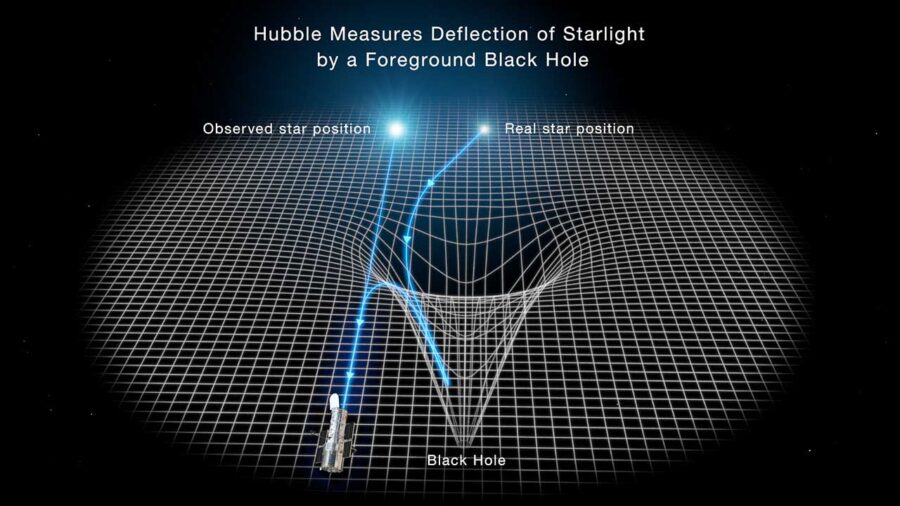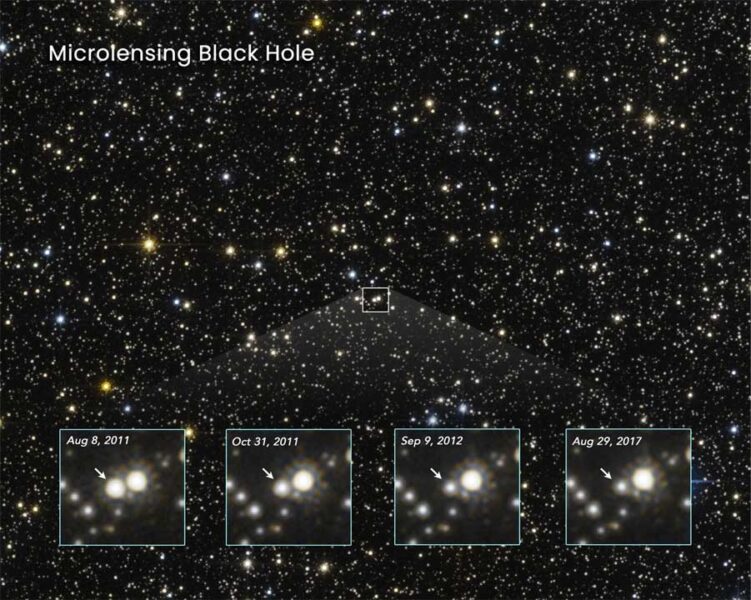17.06.2022
Hubble observations have revealed a stellar-mass compact object — a black hole or possibly a neutron star — wandering our galaxy.

An illustration of a close-up look at a black hole drifting through our Milky Way galaxy.
FECYT / IAC
Two international teams of astronomers may have just used the Hubble Space Telescope to make the first direct detection of a black hole wandering alone through our Milky Way.
Black holes are famously elusive. Their gravity is so extreme that even light cannot outrun them and so there's no light for telescopes to see. Instead, they usually reveal themselves by the way they snack on surrounding material or the influence they have on a neighbour in a binary pair.
Yet there are an estimated 100 million black holes wandering solo through the Milky Way. Finding one has always proved elusive – until now. After decades of monitoring the galactic center with ground-based telescopes, and years of meticulous Hubble observations, astronomers have been able to track down a solitary black hole candidate some 5,000 light-years away in the Carina-Sagittarius arm of our galaxy.
The breakthrough was possible thanks to gravitational microlensing. “[It] is the only technique available for identifying isolated black holes,” says Kailash Sahu (Space Telescope Science Institute, Maryland), who leads one of the teams behind the discovery.
Microlensing relies on a chance alignment between a background light source, such as a star, and a foreground object. The gravity of the foreground object bends the background light around it, magnifying it like a lens. Astronomers looking at this event see a background star suddenly become brighter. The way it brightens tells astronomers a lot about the foreground object, even if it can’t be seen directly.

NASA / ESA / STScI / Joseph Olmsted
In this case, astronomers could tell that the foreground object wasn't an ordinary star. The duration of typical microlensing events ranges from days to weeks, , but the intense gravity of this object stretched it out to almost nine months. The color of the background star also remained constant during this time. Had the foreground object also been a star, their different colors would have temporarily mixed during the microlensing event.
Intrigued, Sahu's team, and another led by Casey Lam (University of California, Berkeley), followed up with the Hubble Space Telescope. Both teams made extremely precise measurements to calculate how much the background star's light was deflected, which in turn enabled them to calculate the foreground object's mass. The deflection was just 1 milliarcsecond. That’s the equivalent of measuring the height of an adult human lying on the surface of the Moon from the Earth.

Science: NASA / ESA / Kailash Sahu (STScI); Image processing: Joseph DePasquale (STScI)
It took several years to gather enough data, partly because there was another bright background star very close to the star being lensed. “It’s like trying to measure the tiny motion of a firefly next to a bright light bulb,” says Sahu. The teams had to meticulously subtract the light of the bright star.
That complexity resulted in the teams arriving at different answers for the foreground object's mass. Sahu's team says 7 solar masses; Lam's between 1.6 and 4.4 solar masses. The latter leaves the exact nature of this object open to interpretation: If it's at the upper end of the range then it likely is a solitary black hole, but the lower end implies something else entirely.
"As much as we would like to say it is definitively a black hole, we must report all allowed solutions,” says Jessica Lu of the Berkeley team. “This includes both lower-mass black holes and possibly even a neutron star.” A neutron star is another, albeit less massive, stellar corpse.
“This is a very exciting discovery,” says Adam Ingram (Newcastle University, UK), who wasn’t involved in the study. He says we need more observational input if we're to understand how stellar mass black holes form and evolve. So far, we've been restricted to looking at X-ray-producing black holes with companions and gravitational-wave-producing black hole mergers, but these are extreme examples.
“It’s like trying to work out how fast humans can run, but the only information you have is from watching Usain Bolt in the Olympics,” Ingram says. If astronomers can measure the mass of more isolated black holes using the lensing technique, they'll get a better feel for what “normal” black holes are like.
Quelle: Sky&Telescope
